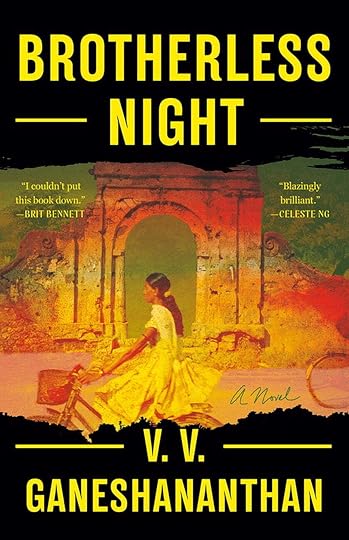Stephen Hong Sohn's Blog, page 6
January 28, 2025
A Review of Rachel Khong’s Real Americans (Knopf, 2024)
![[personal profile]](https://i.gr-assets.com/images/S/compressed.photo.goodreads.com/hostedimages/1491408111i/22407843.png) lsobiesk
lsobiesk
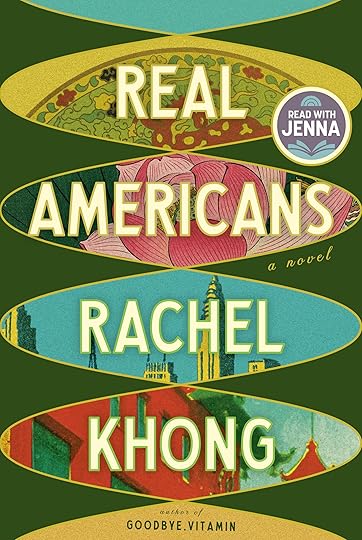
Written by Stephen Hong Sohn
Edited by Lizzy Sobiesk
Rachel Khong’s Real Americans (Knopf, 2024) was recommended to me by Nadeen K, a brilliant former student of mine, quite a while ago, but I didn’t get around to reading it until recently. In fact, I had to have a fairly serious health procedure. On the day of that procedure, I brought this book with me into the surgical waiting room, where I proceeded to have to wait for over 2.5 hours. I was so glad this book was the one I had with me, because: 1) it is fairly long and 2) it was extremely immersive. Let’s let the description get us started: “Real Americans begins on the precipice of Y2K in New York City, when twenty-two-year-old Lily Chen, an unpaid intern at a slick media company, meets Matthew. Matthew is everything Lily is not: easygoing and effortlessly attractive, a native East Coaster, and, most notably, heir to a vast pharmaceutical empire. Lily couldn't be more different: flat-broke, raised in Tampa, the only child of scientists who fled Mao’s Cultural Revolution. Despite all this, Lily and Matthew fall in love. In 2021, fifteen-year-old Nick Chen has never felt like he belonged on the isolated Washington island where he lives with his single mother, Lily. He can't shake the sense she's hiding something. When Nick sets out to find his biological father, the journey threatens to raise more questions than it provides answers. In immersive, moving prose, Rachel Khong weaves a profound tale of class and striving, race and visibility, and family and inheritance—a story of trust, forgiveness, and finally coming home. Exuberant and explosive, Real Americans is a social novel par excellence that asks: Are we destined, or made? And if we are made, who gets to do the making? Can our genetic past be overcome?”
Ah, even this description uses the word immersive, so we’re of like minds =). In any case, the novel is essentially split into two parts, with each sort of mirroring the other. It’s hard to discuss the second section without some plot spoilers, so you are forewarned. The first section first proceeds like a Hollywood meet cute. Matthew and Lily meet at some party; they strike a connection and then suddenly they are off to Paris! Matthew is loaded, Lily is not, but love has no bounds in the fictional world, so they get together. Problems arise down the road though: Lily is having trouble getting pregnant. Eventually, they conceive, but the details around this birth is something that causes a rift to occur between Lily and Matthew, as well as Lily and her parents. What readers discover is that Lily’s and Matthew’s parents already know each other and that their connection involves the scientific backgrounds of Lily’s parents. The information that Lily discovers in the wake of her pregnancy and childbirth leads her to make a radical decision to completely break ties not only with Matthew but also her parents. The second section of the novel then moves us to the Pacific Northwest where Lily is raising Nick with almost zero information about Nick’s grandparents or his biological father. We don’t know exactly the particulars of the fissure quite yet; these contexts are revealed only after Nick goes through a rift similar to the one between Lily and her parents. Nick realizes his mother has been withholding information about his background, which he discovers after he reconnects to his father. Nick eventually comes into contact with Lily’s mother, who reveals everything behind Lily’s pregnancy and what happened between Lily, her parents, Matthew, and Matthew’s family. What I loved most about this novel is the very compelling narrative voices. There is also a slight speculative conceit with this novel, as Lily’s mother, Lily, and Matthew all share the ability to stretch out time. This element also seemed to dovetail with a science fictional engagement with bioengineering, which is connected to how Matthew is able to be conceived. I also found the conclusion very moving, as it explores how difficult it can be to raise children across multiple generations and in the shadow of complicated secrets.
Buy the Book Here
 comments
comments
January 24, 2025
A Review of Olivie Blake’s The Atlas Complex (Tor, 2024)
![[personal profile]](https://i.gr-assets.com/images/S/compressed.photo.goodreads.com/hostedimages/1491408111i/22407843.png) lsobiesk
lsobiesk
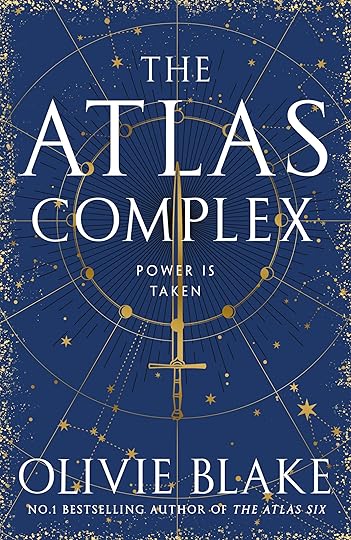
Written by Stephen Hong Sohn
Edited by Lizzy Sobiesk
So, I leave us with a review of the final installment: Olivie Blake’s The Atlas Complex (Tor, 2024). Again, I must briefly make my spoiler warning before providing us with the marketing description: “An explosive return to the library leaves the six Alexandrians vulnerable to the lethal terms of their recruitment. Old alliances quickly fracture as the initiates take opposing strategies as to how to deal with the deadly bargain they have so far failed to uphold. Those who remain with the archives wrestle with the ethics of their astronomical abilities, while elsewhere, an unlikely pair from the Society cohort partner to influence politics on a global stage. And still the outside world mobilizes to destroy them, while the Caretaker himself, Atlas Blakely, may yet succeed with a plan foreseen to have world-ending stakes. It’s a race to survive as the six Society recruits are faced with the question of what they're willing to betray for limitless power—and who will be destroyed along the way.”
The description is somewhat off, since Atlas Blakely is dead, killed by the hand of Libby Rhodes, who has unleashed her full medeian potential. Meanwhile, the “lethal terms of their recruitment” mean that one in every cohort needs to die. Atlas’s cohort didn’t follow this rule, believing they could skirt around it. What happened when they tried to avoid having to sacrifice a member of their cohort was that every single member of that cohort eventually died instead of one. Thus, the six that Atlas himself recruited in book 1 realize that they have to figure out the appropriate sacrifice from their grouping in order to avoid the same outcome. The problem is: who should be killed? This question is more complicated than one thinks, because apparently, there is a right answer. One of the six is supposed to be most deserving of being killed off, and only the archives, which are the sentient knowledge source from which all the magical texts come from, can be the arbiter of whether or not the sacrifice is appropriate. Blake has a ton to deal with in this text. She added another wrinkle into the equation by introducing the Forum, an organization hell-bent on ending the Society and disseminating all the information in the archives itself. In my humble opinion, there was a little bit too much to wrap up here, and I definitely wanted more information about the rules of this world. For instance, we discover that Dalton Emery, a medeian with the power to animate and create life, doesn’t fully realize that his power might have to draw this life force from somewhere else. This element is the huge question that I still have about this particular installment. In fact, I still do not understand why the archives require a sacrifice at all and wonder if it is connected to the cost that exists to use magic in this world. In any case, the final piece of this trilogy is certainly exciting and for this reason alone, I do think many dark fantasy readers will want to give it a shot, but the ending is truly going to be polarizing. The choice of who dies is not going to sit well with all readers. While I felt Libby’s character development made sense (despite the devastating direction she went), it was one of her foils, Parisa Kamali, that I had the hardest trouble wrapping my head around. Finally, I did find the character dynamics to be quite frustrating, only because so many of the characters seemed to detest each other for most of the three books, and this level of tension could be exhausting, at least to me. Despite my critiques, I am going to be incredibly clear: Blake is obviously super talented and can really drive a story forward with energetic momentum. The books themselves are gorgeous publications, with some fully sketched out images of characters, which only add to the quality of the overall work. And I know I’m going to find someone who has read the work, if only to ask the questions I’ve brought up here. I’ll definitely read as much of Blake’s other publications that I can, and there are many!
Buy the Book Here
 comments
comments
A Review of Olivie Blake’s The Atlas Paradox (Tor, 2022)
![[personal profile]](https://i.gr-assets.com/images/S/compressed.photo.goodreads.com/hostedimages/1491408111i/22407843.png) lsobiesk
lsobiesk
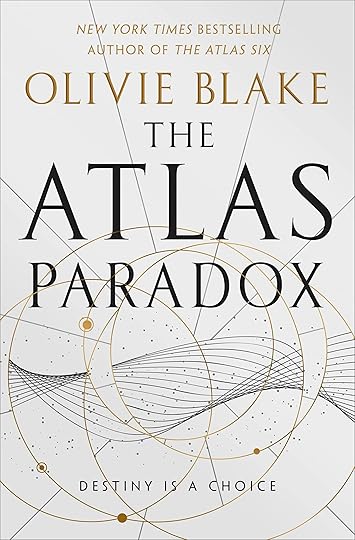
Written by Stephen Hong Sohn
Edited by Lizzy Sobiesk
Olivie Blake’s The Atlas Paradox (Tor, 2022) was published in the same year as the first installment. I have to think that Blake must have had at least most of this novel drafted already since getting her contract, with this one coming out so quickly and being so lengthy! In any case, this one begins basically where the last began, and I do need to provide spoilers at this point only because, well, it’s hard to say what’s going on in this one without telling you what happened in the last one. So, spoiler warning here . . . the actual marketing description is super pithy: “Six magicians were presented with the opportunity of a lifetime. Five are now members of the Society. Two paths lie before them. All must pick a side. Alliances will be tested, hearts will be broken, and The Society of Alexandrians will be revealed for what it is: a secret society with raw, world-changing power, headed by a man whose plans to change life as we know it are already under way.”
When looking back on this one, I’m not really sure what sides we’re talking about, except for the fact that we now know what Atlas Blake is sort of up to. He wants to be able to warp time and space to open up a kind of multiverse. This process requires the talents of the current six, one of whom is trapped now in the past (Libby Rhodes). I guess there is the side that wants Atlas to succeed, and the side that wants Atlas to fail, which is currently being led by Ezra Fowler, who, as we discover, is not just Libby’s ex-boyfriend but also a very powerful medeian and part of Atlas’s class of initiates way back when both were just starting out. The middle in a trilogy is typically the saggiest, and this installment suffers from some of the lag. Here, Blake has to get Libby Rhodes back out from the past but also has to ensure that there is some sort of relevant plotting there so that this type of deviation is robust enough to provide us with some serious content. Rhodes is stuck with the limitations of ‘90s technology, while also realizing that her path forward will require her to make a very destructive decision. Back in the present, the five initiates are left wonder where Libby is, while they all make their own way through the archives. Indeed, they are supposed to be fulfilling some sort of research assignment related to their second years as initiates. On the side, Tristan and Nico devise ways to contact Libby even across time, which requires the help of Gideon, Nico’s friend and possible romantic partner. Gideon, part-mermaid apparently (um yeah, hard to explain this particular motif in this fictional world), can traverse dreamworlds and can cross time and space through this arena and can help to communicate with Libby. Ultimately though, Libby does come back, and her choice essentially requires her to set off a nuclear reaction in order to do so. The price is high: the area where the explosion occurs will of course be irradiated for decades, even if no one actually or directly dies near the site. The conclusion of this book sees one possible death and two definite deaths. Libby’s romantic partner, Belen, in the past, is discovered to be part of the Forum, a group that works directly against The Society, in the future. Belen has some sort of medical event that leaves her indisposed, while it looks likely that Libby kills Ezra (well, for basically kidnapping her and lying about their relationship, etc.) and then kills Atlas (for being megalomaniacal and hiding his true intent as caretaker). This ending sets up new dynamics for the third, as a new set of animosities occurs once Ezra and Atlas are ultimately killed off.
Buy the Book Here
 comments
comments
January 17, 2025
A Review of Olivie Blake’s The Atlas Six (Tor, 2022)
![[personal profile]](https://i.gr-assets.com/images/S/compressed.photo.goodreads.com/hostedimages/1491408111i/22407843.png) lsobiesk
lsobiesk
[image error]
[image error]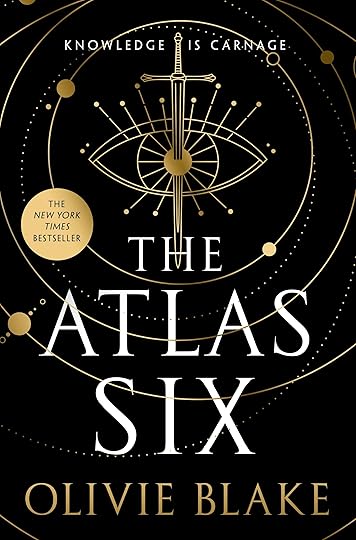
Written by Stephen Hong Sohn
Edited by Lizzy Sobiesk
I actually waited to read Olivie Blake’s The Atlas Six (Tor, 2022) after Blake had finished the entire Atlas trilogy. I will admit that I have become a little bit tired of reading the first in an installment only to forget what had happened while waiting for the next iteration to come out. Such is not the case now with Blake, and I review The Atlas Six, which has become a bestseller since its publication. This novel follows in the tradition of what has been termed the dark academy fantasy genre. The clearest analogues by Asian American authors that I can think of offhand are R.F. Kuang’s Babel, Kuang’s Poppy War trilogy, and M.L. Wang’s Blood over Bright Haven. Fonda Lee’s Jade trilogy I would say also has some of the dark academy fantasy components to it as well. Key to the dark academy fantasy genre is that the training specific characters undergo involves magical abilities. Second, the dark academy fantasy genre obviously has a dark element to it. That is, there is something dystopian or unethical either about the academy itself or the ways in which the characters will ultimately go on to use their magical powers (after having been trained). In Blake’s novel, there are six initiates who are invited to join a magical society. Their contact is none other than a mysterious fellow named Atlas Blake (hence the trilogy’s name). The number of initiates alongside Atlas’s name is the foundation of the book’s title. Each of the six have been chosen for their exceptional abilities in a magical discipline. There’s Libby Rhodes and Nico Varona, who are both gifted in their ability to wield particular physical elements. Reiko Mori is a powerful naturalist, with unique connections to the environment and plant life. Parisa Kamali is an incredible telepath; Tristan Caine is a skilled illusionist; and Callum Nova is a talented empath, who has the ability to manipulate other people’s emotions. All the six are told is that they must spend a year training and studying at a specific, private location, with the acknowledgment that, eventually, one of the six will be eliminated from the group. Thus, only five will be allowed to join.
The reason why the six are even interested is that the magical society offers them the chance to harness and to enhance their powers, while giving them access to a world-class archive that will only increase their knowledge. The problem is that they do not know exactly how one of them will be eliminated, and now is the time where I need to provide my requisite spoiler warning. Please turn away unless you want to find out exactly what the initiates discover. They all eventually realize that the sixth person is eliminated via their death. The manner of death might be through homicide (in the sense that five conspire against one to kill the sixth) or it might be a sacrifice (where a single individual decides to give up their life voluntarily). Whatever the case, a death seems destined to occur in some form or another. Given the incredible power the society offers, most of the six seem to rationalize that this type of elimination is fine. This area is the one that I found the hardest to deal with as a reader, as I didn’t find many of the characters to be remotely sympathetic. Indeed, this aspect was perhaps my biggest block to reading the book. The plot, its conceits, the various issues connected with the society, were all compellingly presented, but the characters themselves and their psychic interiorities I often found unsavory. Admittedly, Blake does imbue all the major characters with complexity, which is ultimately why I will continue on with this series, but it remains to be seen whether or not these characters will have developmental arcs in which they might actually realize that their pursuits of magical power might not be the best thing for them. I will likely have to reveal how this novel ends at some point early on in the review for the next book, but suffice it to say, someone is eliminated but just not in the way anyone expects. For this kind of surprise conclusion, I applaud Blake for lining up her representational chess pieces with such mastery. An A+ for the magical worldbuilding as well!
Buy the Book Here
 comments
comments
November 6, 2024
A Review of V.V. Ganeshananthan’s Brotherless Night (Random House, 2023)
![[personal profile]](https://i.gr-assets.com/images/S/compressed.photo.goodreads.com/hostedimages/1491408111i/22407843.png) lsobiesk
lsobiesk
Written by Stephen Hong Sohn
Edited by Lizzy Sobiesk
V.V. Ganeshananthan’s Brotherless Night (Random House, 2023) is an absolute punch to the gut. I couldn’t finish this novel easily. I had to take breaks. At some point, I realized that it might be a good subway reading novel, where I only have 30-minute segments to get immersed. This approach proved to be the best one, as I finished it this way. In any case, the marketing description will provide us with a great introduction: “Jaffna, 1981. Sixteen-year-old Sashi wants to become a doctor. But over the next decade, a vicious civil war tears through her home, and her dream spins off course as she sees her four beloved brothers and their friend K swept up in the mounting violence. Desperate to act, Sashi accepts K’s invitation to work as a medic at a field hospital for the militant Tamil Tigers, who, following years of state discrimination and violence, are fighting for a separate homeland for Sri Lanka’s Tamil minority. But after the Tigers murder one of her teachers and Indian peacekeepers arrive only to commit further atrocities, Sashi begins to question where she stands. When one of her medical school professors, a Tamil feminist and dissident, invites her to join a secret project documenting human rights violations, she embarks on a dangerous path that will change her forever. Set during the early years of Sri Lanka’s three-decade civil war, Brotherless Night is a heartrending portrait of one woman’s moral journey and a testament to both the enduring impact of war and the bonds of home.”
I wish the description actually named the four brothers that Sashi has; they are Niranjan, Seelan, Dayalan, and Aran. As you might have guessed, the “brotherless” in the title refers to the fact that one of Sashi’s siblings will die. The older, Naranjan, will be killed in anti-Tamil violence. This moment will prove to be instrumental for the eventual disintegration of family bonds. It spurs Seelan and Dayalan into joining the Tamil Tigers; K will also join up at this point. Sashi is forced to navigate this complicated political territory. On the one hand, she does not want her surviving brothers to die, but on the other, she is not interested in becoming part of the movement herself. She does provide some of the Tamil Tigers with her medical expertise, especially once she starts her schooling. Sashi is a character who will not refuse to sit by and watch her neighbors, her friends, family members, and even strangers die. She is a healer and archivist at heart; despite so much danger, Sashi stays true to her principles. The novel does ultimately reveal that Sashi will eventually lose all of her brothers in way or another, whether to the movement or to the fact that she will figuratively or metaphorically betray them. In this respect, the novel’s most profound devastations occur because the family’s ultimate dissolution is one that is being mirrored in many families across Sri Lanka. A late-stage character that serves as a kind of foil to Sashi, one that also has four brothers, is crucial to Sashi’s final arc, as she comes to realize what it is she must do and where it is she must ultimately go. Ganeshananthan’s work is a morally complex representation in a time of great polarization. I could not sleep well after I finished this work, because it speaks so much to our current moment. Adding to the incredible political texture of this work is Ganeshananthan’s always gorgeous prose (check out her previous Love Marriage as evidence), so despite some of the darkest depictions, you’ll sometimes be buoyed by the way Ganeshananthan’s is able to breathe so much vivacity into Sashi, a character we will hold fast to in these turbulent times.
Buy the Book Here
 comments
comments
November 4, 2024
A Review of Thien Pham’s Family Style (First Second, 2023).
![[personal profile]](https://i.gr-assets.com/images/S/compressed.photo.goodreads.com/hostedimages/1491408111i/22407843.png) lsobiesk
lsobiesk

Written by Stephen Hong Sohn
Edited by Lizzy Sobiesk
Ah, I saved reading Thien Pham’s Family Style (First Second, 2023) for a period when I needed something I knew was going to be good, and I’m happy I did. Thien Pham is someone whose career I’ve been following ever since I started teaching graphic narratives at Stanford. He’s collaborated with a number of other prominent graphic narratives auteurs including Gene Luen Yang. Let’s let the official marketing description give us some key contexts: “Thien's first memory isn't a sight or a sound. It's the sweetness of watermelon and the saltiness of fish. It's the taste of the foods he ate while adrift at sea as his family fled Vietnam. After the Pham family arrives at a refugee camp in Thailand, they struggle to survive. Things don't get much easier once they resettle in California. And through each chapter of their lives, food takes on a new meaning. Strawberries come to signify struggle as Thien's mom and dad look for work. Potato chips are an indulgence that bring Thien so much joy that they become a necessity. Behind every cut of steak and inside every croissant lies a story. And for Thien Pham, that story is about a search—for belonging, for happiness, for the American dream.”
I love this description because it reminds me of a story my mother always told me when she was alive: the taste of a Baby Ruth bar when she was starving as a refugee in the Korean War. There is a sequence something like this tale my mother told me early on in Pham’s memoir. They are escaping by boat from Vietnam. As sometimes occurred, pirates targeted refugees, and Pham’s family must endure this assault. Once it is over, Pham eats a salty rice ball, which is a food memory which stays with him the rest of his life. From that first chapter, you see Pham explore the complications of growing up in the United States. The majority of the memoir, not surprisingly, deals with this early period where the family struggles to acculturate, on the one hand, and then begins to adapt and to find stability in their new home, on the other. The care and tenderness with which Pham portrays his family’s struggles and triumphs make Family Style incredibly poignant. Pham’s signature artistic style carries over from his earlier publication Sumo; there’s always a cool cartoon-ish vibe going on, which contrasts effectively with some of the heavier topics. As the narrative concludes, we see the memoir get explicitly political in the sense that Pham is driven to get his citizenship precisely because he wants to be able to cast his vote and participate in a democratically-informed American future. This message perhaps could not come at a better time, given the turbulence we have faced in the United States, especially over the last year. Certainly, a graphic narrative to add to the mix of the ones I currently teach =).
Buy the Book Here
 comments
comments
October 29, 2024
A Review of Isabel Cañas’s Vampires of El Norte (Berkeley 2023)
![[personal profile]](https://i.gr-assets.com/images/S/compressed.photo.goodreads.com/hostedimages/1491408111i/22407843.png) lsobiesk
lsobiesk

Written by Stephen Hong Sohn
Edited by Lizzy Sobiesk
So, I’m going to be entirely frank here: the horror intensity of the novel is not necessarily on the highest level, though there are definitely some dreadful and terrifying sequences. Cañas is admittedly balancing a lot. This novel is a not only a historical fiction, but it’s also a frontier romance, a western, and a kind of supernatural horror novel all rolled into one. It’s not easy to cultivate each of these areas. Of these various elements, I do think Cañas is most successful in the romance narrative department, as we are no doubt rooting for Nena and Néstor, and they come from different class backgrounds, making their pairing all the more difficult. What the two have going for them is that they are willing to have each other’s backs in the most difficult of circumstances. Whether they are battling for their land against the yanquis, trying to fend off the supernatural evil that are vampires, or going up against the social mores that demand that the two find other partners, Cañas has us cheering for these leads. I sometimes teach a monster theory reading, and what’s interesting to me about this novel is that Cañas, like many other BIPOC writers, is somewhat skeptical of any essentialized villainy. Indeed, in this novel’s case, even something as terrifying as supernatural vampires is undermined the conclusion. We are left to consider the possibility that the bloodsucking might of these creatures may have been harnessed by the yanquis and that these monsters may simply be a variation on a type of large animal who possesses a particularly strong predatory instinct, something more akin to a lizard or shark rather than something too strange or alien. Ultimately, Cañas’s text is immensely readable and perfectly appropriate to consume in the lead-up to Halloween. Frightful and romantic somehow all at the same time!
Buy the Book Here
 comments
comments
October 24, 2024
A Review of Kazu Kibuishi’s Waverider (Amulet #9) (Scholastic, 2024)
![[personal profile]](https://i.gr-assets.com/images/S/compressed.photo.goodreads.com/hostedimages/1491408111i/22407843.png) lsobiesk
lsobiesk

Written by Stephen Hong Sohn
Edited by Lizzy Sobiesk
For a moment there, I was worried that Kazu Kibuishi might never finish this series. I actually didn’t expect that Waverider, which is #9 in the Amulet series, would be the conclusion. I figured that it might be #10, but hey, when a story ends, it must end =). In any case, the short marketing description can be found here: “After her confrontation with Ikol, Emily finally understands the stone's power and what she must do to defend Alledia from the shadows. As she travels to Typhon to help her mom and Navin, Prince Trellis returns to the Kingdom of the Elves to save his countrymen — and confront the fraud who has seized power in the absence of a king. The threat of darkness follows all Stonekeepers closely, and it will take the strength of both new friends and old foes to conquer it... and survive.”
I’ve always loved this series; it’s primarily high fantasy, as it takes place in other magical locations that include animals that speak, strange creatures, sentient AI, among others. As with many other texts (including The Lord of the Rings, which Kibuishi must have been a fan of), the power that comes with something magical is an ambivalent one. The stonekeepers can help advocate for others or they might fall prey to the desire to dominate. Emily herself must figure out her own path. As the description mentions, Emily’s unraveling of IKOL’s background is crucial, as it provides her with the information she needs to confront the larger menace facing Alledia. I’ll provide my short spoiler warning here to give some time to look away if needed. What Emily finds out is that IKOL is a kind of rogue program designed by sentient artificial intelligence, so she begins to realize that the enemy did not come out of some magical vacuum. The final installment also really becomes a family-friendly affair, as various characters have to work together to dispense with the shadows and enable these magical locations to be free. The quest arc, while being wrapped up more quickly than I would have liked, is nevertheless fittingly and logically closed, with Emily being the kind of heroine any reader would want to root for. She takes up the incredible responsibility she has in order to protect others and rises to the challenge to be a leader in dark times. Certainly, a fictional character we can aspire to be, as we move forward in such turbulent moments in our own so-called reality. I’ll miss Kibuishi’s series and the lovely drawings, but I’m sure there’ll be lots more to see from him.
Buy the Book Here
 comments
comments
October 23, 2024
A Review of Sophie Kim’s The God and the Gumiho (Del Rey, 2024)
![[personal profile]](https://i.gr-assets.com/images/S/compressed.photo.goodreads.com/hostedimages/1491408111i/22407843.png) lsobiesk
lsobiesk
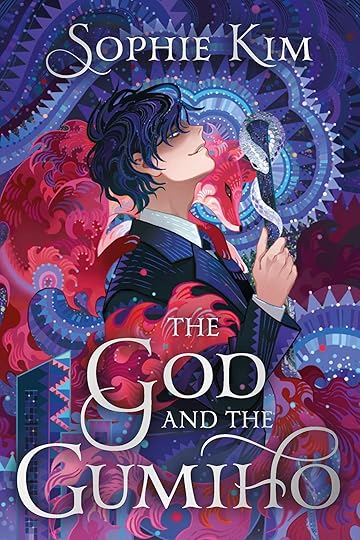
Written by Stephen Hong Sohn
Edited by Lizzy Sobiesk
Ah, well, Sophie Kim’s The God and the Gumiho (Del Rey, 2024) took me by surprise. This interesting semi-low fantasy novel was the one I decided to take with me on a cross-country plane flight. It seemed just long enough, clocking in around 400 pages. I did finish it slightly before the flight touched down, but that was partially because the plot was pretty engaging =). In any case, there is quite the meaty marketing description to give us some key information about this novel: “Kim Hani has retired from a life of devouring souls. She is, simply put, too full. Once known as the infamous Scarlet Fox, she now spends her days working in a coffee shop and annoying a particularly irritating, if unfairly handsome, trickster god as often as she can. That god is Seokga the Fallen. Exiled from the heavenly kingdom of Okhwang, he now begrudgingly resides in the mortal realm, working toward his redemption and suffering through his interactions with the particularly infuriating, if sneakily charming, gumiho barista at his favorite café. But when a powerful demon escapes from the underworld and threatens to end all of humanity, Okhwang’s emperor offers Seokga an enticing bargain: Kill this rogue creature, as well as the legendary and elusive Scarlet Fox, and he will be reinstated as a god. Hani, however, has no intention of being caught. Seokga might be a trickster god, but she has a trick of her own that he’ll never see coming: teaming up. As Seokga’s assistant, Hani will undermine and sabotage his investigation right under his overly pointy nose. Sure, she’ll help him kill the demon, but she certainly won’t allow him to uncover her secret identity while they’re at it. As the bickering partners track their case down a path of mayhem and violence, the god and the gumiho find themselves inescapably drawn to each other. But will the unlikely couple stand together to prevent the apocalypse, or will they let their secrets tear them—and the world—apart?”
As I mentioned in another review, the gumiho—otherwise known as the Korean fox demon lady—is truly having a moment. I just finished reading Fox Maidens by Robin Ha, so I was already in a foxy mood, and then I chanced upon this novel and figured it would be right up my alley. The description sets up the novel quite well as the power demon that escapes from the underworld is none other than one who can shapeshift and violently tear apart the bodies of magical creatures. Kim’s world-building is really fun. The magical world of demons, demigods, goblins, and other monsters appears as an overlay on top of the mortal world, but mortals cannot see or really interact with this other realm. Whatever the case, the novel is ultimately a kind of mash-up of fantasy, detective fiction, and romance. The latter genre element I was probably least prepared for, but Kim obviously has set her sights on this type of hybrid narrative, one that reminds me of the paranormal romance to a certain extent. Despite the fact that Seokga is cold and sort of self-absorbed and Hani is quite the enterprising killer of men, somehow you still find yourself rooting that these two oddballs will get together. In this way, Kim clearly knows how to work with the romance narrative as a kind of formula. For whatever reason, I didn’t find this romance to be as distracting to the plot, but I think it’s because Kim sort of has a campy, comedic undertone that appears throughout the narrative. Kim is aware enough that she needs to be hyperbolic in this kind of world in which grim reapers wear black and only order black coffees and magazine publications exist with names like Godly Gossip. It is this balance of humor and plot-driven dynamics involving the quest to find the deadly demon that truly makes this one a fun, fantastical romp.
Buy the Book Here
 comments
comments
October 17, 2024
A Review of Kaveh Akbar’s Martyr! (Knopf, 2024)
![[personal profile]](https://i.gr-assets.com/images/S/compressed.photo.goodreads.com/hostedimages/1491408111i/22407843.png) lsobiesk
lsobiesk
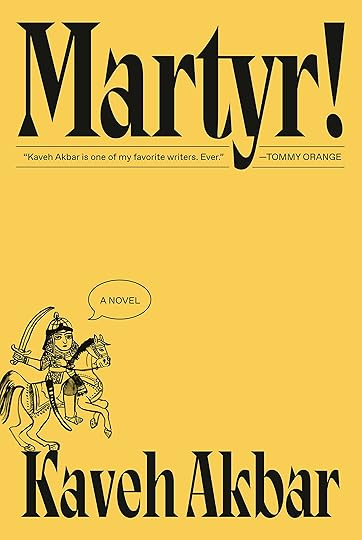
Written by Stephen Hong Sohn
Edited by Lizzy Sobiesk
Occasionally, we consider the most flexible capacities in defining Asian American literature, and we look just West from Afghanistan to cover Kaveh Akbar’s Martyr! (Knopf, 2024), which is all about an Iranian diasporic context. Let’s let the pithy marketing description get us somewhat situated: “Cyrus Shams is a young man grappling with an inheritance of violence and loss: his mother’s plane was shot down over the skies of the Persian Gulf in a senseless accident; and his father’s life in America was circumscribed by his work killing chickens at a factory farm in the Midwest. Cyrus is a drunk, an addict, and a poet, whose obsession with martyrs leads him to examine the mysteries of his past—toward an uncle who rode through Iranian battlefields dressed as the angel of death to inspire and comfort the dying, and toward his mother, through a painting discovered in a Brooklyn art gallery that suggests she may not have been who or what she seemed.”
This description leaves out Cyrus’s crucial friendship, not-quite-fully-romantic relationship with Zee, a mixed ethnicity Egyptian American. Akbar’s poetic sensibilities—he is the author of a number of poetry collections, and I believe this publication is his first novelistic foray—are on full display here, as he uses parataxis as a technique to provide us with multiple perspectives. We consistently get first person perspectives of other characters, including Cyrus’s father and mother. The description doesn’t mention the fact that Cyrus’s father dies just after Cyrus enters his college years. Cyrus has something of a death-wish, which explains his huge interest in martyrs, and why he is writing a potential book about them. He wants his death, whenever that may come, to have meaning, which is why he continues to research these figures. He eventually comes upon a performance artist who is completing a kind of dying-installation at a NYC museum. Her name is Orkideh and has terminal cancer. Cyrus finds himself drawn to Orkideh, who Cyrus sees as a modern-day martyr. It just happens to be that Orkideh is also of Iranian ethnicity, so they do have an important connection. Here, I will pause for the requisite spoiler just because this novel has a major twist, so look away now. In any case, the big issue that readers will have to grapple with is the eventual revelation that Orkideh is in fact Cyrus’s mother! *gasp* Yes, you heard it right. Originally, readers will think she has died in a plane crash in 1984 (a historically-specific crash), taken down by the US military. Eventually, we realize that Orkideh (real name Roya and Cyrus’s mother) had swapped identities with her same sex lover Leila, hoping that they could reunite elsewhere, especially in the wake of Leila’s husband finding out about their lesbian affair. Roya ends up in Turkey and then manages to get to NYC, and she realizes that she cannot now go back to her former life and decides to live out her choices. Leila of course has died, though everyone else believes that Roya was the one who had perished in the plane crash. This information Cyrus receives belatedly by the curator who eventually meets Roya/Orkideh and helps to launch Roya/Orkedeh’s career. While readers will probably have divergent responses to this revelation, I did think that the novel operated quite ingeniously as a queer diasporic narrative. Whereas the predominant homosocial narratives write out any minor character marked as queer, this novel operates sort of in the reverse. It is Ali Shams (Cyrus’s father) who exits first, even though we do think Roya is initially dead. The novel thus becomes a queer intergenerational immigration saga, which I found incredibly interesting. Indeed, by novel’s end, Cyrus begins to realize that his relationship with Zee is not just some casual, friendly, semi-erotic affair, and that he must realize the depth of their feelings toward each other. It is this kind of concluding arc that really makes this novel brim with possibility, even despite the apocalyptic undertones that filer throughout. A poignant debut!
Buy the Book Here
 comments
comments

